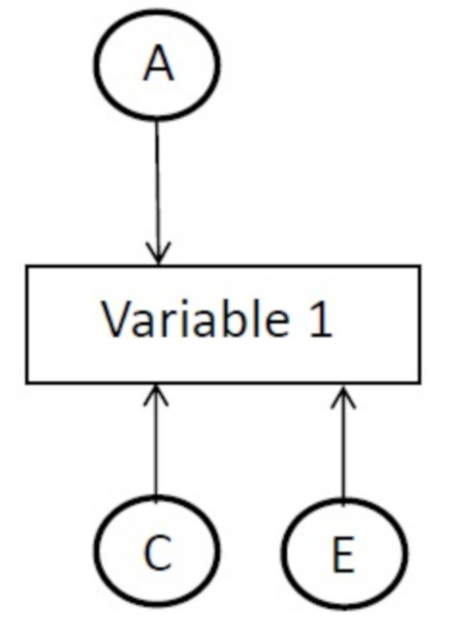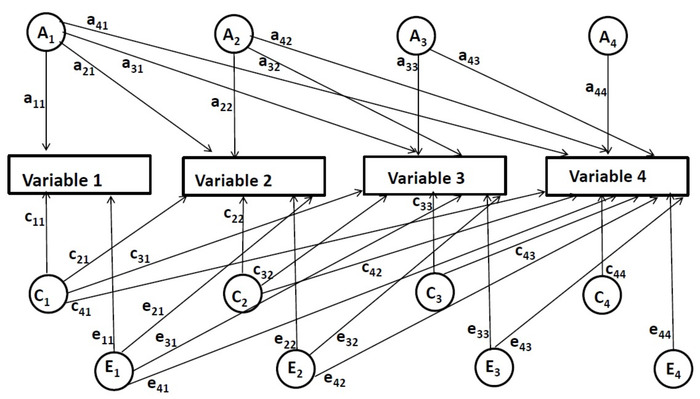Using Cholesky Decomposition to Explore Individual Differences in Longitudinal Relations between Reading Skills
Summary
This paper demonstrates use of the gold standard method in behavioral genetics, the Cholesky decomposition method, to estimate unique, overlapping genetic and environmental influences on different variables to answer longitudinally motivated research questions.
Abstract
The Cholesky decomposition method is the gold standard used in the field of behavioral genetics. The method is popular because it is easy to program and solve. Using this method, researchers can explore individual differences in longitudinal relations of different variables across multiple time points. The method allows investigators to decompose variance into (1) unique genetic, shared and non-shared environmental effects that arise at specific time points as well as (2) overlapping genetic, shared and non-shared environmental effects that carry over from one time point to another. However, the method does not identify the mechanisms or origins underlying these effects. The current report focuses on application of the Cholesky decomposition method in the field of educational psychology. Specifically, it discusses individual differences in longitudinal relations between kindergarten letter knowledge, kindergarten phonological awareness, first grade word-level reading skills, and seventh grade reading comprehension.
Introduction
Becoming a skilled reader with the ability to fluently read and comprehend text is important for children’s school outcomes. To prevent the development of reading problems, it is vital to understand the extent to which different reading skills predict reading comprehension. Existing research has shown that pre-reading and word-level reading skills in elementary school longitudinally predict reading comprehension in middle school1,2. Individual differences in these predictions mostly point to underlying genetic (and to some extent, environmental) factors from kindergarten up to grade four3,4. However, there is a need to explore whether these same genetic and environmental factors continue to influence these predictions up to middle school grades.
One method to gain a better understanding of individual differences underlying the associations between elementary and middle school reading skills is using behavioral genetic methodology, specifically the Cholesky decomposition method. The Cholesky decomposition method is considered one of the gold standard analyses in behavioral genetics. This method is easy to program and solve and allows for the decomposition of variance and covariance into (A) genetic, (C) shared environmental, and (E) non-shared environmental influences, usually in a sample of twins. An example of a univariate (one variable) Cholesky decomposition is indicated in Figure 1. The A latent factor refers to genetic effects, which are genetic influences inherited from parents. The C latent factor refers to shared environmental effects, which are aspects of the environment that serve to make twins more similar, such as home and school environments. Lastly, the E latent factor refers to non-shared environmental effects, which are environmental influences that are unique to each twin and contribute to differences between twins, such as each’s own experience. The E factor also captures measurement error.

Figure 1: Decomposition into (A) genetic, (C) shared environmental, and (E) non-shared environmental influences. Please click here to view a larger version of this figure.
The A, C, and E factors in Figure 1 estimate the extent to which genes and environments influence one (reading) variable. Still, to investigate individual differences underlying longitudinal associations between more than one reading skill from elementary to middle school, longitudinal analysis is necessary. To answer longitudinally motivated research questions, a multivariate Cholesky decomposition method is used here5. Conceptually, the multivariate Cholesky decomposition method is similar to hierarchical multiple regression, such that independent contribution of genetic and environmental factors is assessed after the contributions of previous factors have been taken into account.
For instance, in a multivariate Cholesky decomposition with longitudinal data at four time points (see Figure 2), the first set of factors [genetic (A1), shared environmental (C1), and non-shared environmental (E1)] contributes to the variance of all variables, represented as paths a11, a21, a31, a41, c11, c21, …, e11, etc., from A1, C1, E1 factors to each variable. The second set of factors (A2, C2, E2) contributes to the variance of the second and subsequent variables after controlling for the first time point. The second set of factors is represented as paths a22, a32, a42, c22, c32, …, e22, etc. Then, influences of the third set of factors (A3, C3, E3) are estimated for the third and fourth variables after controlling for the previous two time points. They are represented as paths a33, a43, c33, c43, e33, e43. Finally, influences of the fourth set of factors (A4, C4, E4) are measured for the final time point after controlling for all previous time points. They are represented as paths a44, c44, e44.

Figure 2: Multivariate Cholesky decomposition model for four time points. Please click here to view a larger version of this figure.
In this longitudinal application of the multivariate Cholesky decomposition method, genetic and environmental influences at each time point are estimated after the effects of previous time points have been controlled for. As such, this method allows determination of the extent to which unique genetic and environmental influences come online at each particular time point, independent of influences from previous time points (these effects are estimated by paths a11, a22, a33, a44, c11, c22, …, e11, e22, etc.). In addition, the method also enables examination of the degree to which the same (overlapping) genetic and environmental influences are shared between time points. In other words, it can be determined to which extent genetic and environmental influences carry over from one time point to another (i.e., these effects are estimated by paths a21, a31, a41, a32, a42, a43, c21, c31, …, e21, etc.). It should be noted that paths a11, c11, and e11 represent all possible genetic and environmental influences up to and including the first time point, which can be either unique or overlapping with previous time points. However, time points prior to the first time point are not estimated; hence, it cannot be accurately determined whether they represent unique or overlapping influences. For simplification purposes, they are included as unique influences in the current report.
The order of the measured variables entered into a Cholesky decomposition is arbitrary. However, the order is usually driven by a theoretical perspective. This is also the case in the current study, in which the order was based on the development of reading skills, such that reading skills in elementary school are predictive of reading comprehension in middle school.
There are several reports in the literature investigating genetic and environmental factors underlying longitudinal associations of reading skills utilizing the Cholesky decomposition method. These prior studies mostly focused on investigating relations between reading skills among elementary schoolers6,7. There is only one published study examining individual differences associated with reading from elementary grades into middle school grades using the multivariate Cholesky decomposition method8. This protocol details the multivariate Cholesky decomposition method from that specific report to explore individual differences in longitudinal relations between kindergarten letter knowledge, kindergarten phonological awareness, first grade word-level reading skills, and seventh grade reading comprehension.
The study findings focus on using the multivariate Cholesky decomposition method to distinguish between two types of genetic and environmental influences. First, it is shown how to estimate genetic and environmental influences that carry over (overlap) from elementary to middle school reading (e.g., estimating paths a43, c43, and e43, which are genetic and environmental influences on word-level reading skills from first grade that affect reading comprehension in seventh grade). Second, it is demonstrated how to estimate unique genetic and environmental influences that come online at each particular grade (e.g., estimating paths a33, c33, and e33, which are unique genetic and environmental influences on word-level reading skills that arise in first grade).
Protocol
Representative Results
Discussion
The objective of this study was to demonstrate how the well-established method within behavioral genetics, the multivariate Cholesky decomposition method, can effectively be used for understanding relations across variables in temporal context. Specifically, this method allows estimation of the extent to which unique genetic and environmental influences arise during particular time points (e.g., school grade), as well as demonstrating the overlap of genetic and environmental influences across many time points.
<p cla…Disclosures
The authors have nothing to disclose.
Acknowledgements
This research was supported in part by a grant from the National Institute of Child Health and Human Development (P50 HD052120). Views expressed herein are those of the authors and have neither been reviewed nor approved by the granting agencies.
Materials
| Microsoft Office Excel | Microsoft | ||
| Microsoft Office Powerpoint | Microsoft | ||
| Microsoft Office Visio | Microsoft | ||
| Microsoft Office Word | Microsoft | ||
| Mplus Statistical Program | Mplus |
References
- Muter, V., Hulme, C., Snowling, M. J., Stevenson, J. Phonemes, rimes, vocabulary and grammatical skills as foundations of early reading development: Evidence from a longitudinal study. Developmental Psychology. 40 (5), 665-681 (2004).
- Schatschneider, C., Fletscher, J. M., Francis, D. J., Carlson, C. D., Foorman, B. R. Kindergarten prediction of reading skills: A longitudinal comparative analysis. Journal of Educational Psychology. 96 (2), 265-282 (2004).
- Byrne, B., et al. Longitudinal twin study of early literacy development: Preschool and kindergarten phases. Scientific Studies of Reading. 9 (3), 219-235 (2005).
- Christopher, M. E., et al. Genetic and environmental etiologies of the longitudinal relations between prereading skills and. Child Development. 86 (2), 342-361 (2015).
- Neale, M. C., Cardon, L. R. . Methodology for Genetic Studies of Twins and Families. , (1992).
- Byrne, B., et al. Genetic and environmental influences on early literacy. Journal of Research in Reading. 29 (1), 33-49 (2006).
- Byrne, B., et al. Genetic and environmental influences on aspects of literacy and language in early childhood: Continuity and change from preschool to grade 2. Journal of Neurolinguistics. 22 (3), 219-236 (2009).
- Erbeli, F., Hart, S. A., Taylor, J. Longitudinal associations among reading related skills and reading comprehension: A twin study. Child Development. 89 (6), e480-e493 (2018).
- Muthén, L. K., Muthén, B. O. . Mplus. The comprehensive modeling program for applied researchers: User’s guide. , (2012).
- Hart, S. A., et al. Exploring how nature and nurture affect the development of reading: An analysis of the Florida Twin Project on Reading. Developmental Psychology. 49 (10), 1971-1981 (2013).
- Taylor, J., Roehrig, A. D., Hensler, B. S., Connor, C. M., Schatschneider, C. Teacher quality moderates the genetic effects on early reading. Science. 328 (5977), 512-514 (2010).

